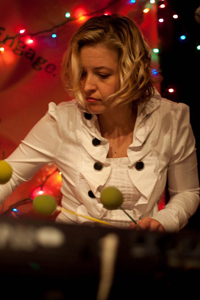Don't see what you're looking for?
Main Site
Berklee.eduCampuses and Schools

Gonzalo Plaza Photography
Vessela Stoyanova
For media inquiries, please contact Media Relations
A widely respected performer, composer, and educator, Vessela Stoyanova is a triple threat on the Boston music scene. Born and raised in Bulgaria, most of her original music is inspired by the folk music of the Balkans. Her compositions have been recorded by numerous ensembles and performed at major Boston-area venues, including the Berklee Performance Center, Jordan Hall, the Loeb Drama Center at the American Repertory Theater, as well as at many smaller venues around the United States and Europe.
As a performer, Vessela combines virtuosic mallet technique with the world of electronics, especially via her prototype instrument the Marimba Lumina—a sophisticated mallet MIDI controller. Currently she performs and writes for two projects: Bury Me Standing (a gypsy dirge-core band) and Goli (a modern chamber music duo), both of which she cofounded. Vessela recently joined the Jazz Composers Alliance and has been a featured soloist for a number of their concerts.
Vessela holds a master’s degree in contemporary improvisation from the New England Conservatory of Music. She is a faculty member at Berklee College of Music, where she teaches Harmony and Marimba during the regular school year, and a Balkan ensemble during the Five-Week Summer Performance Program.
- Cofounder, cocomposer, and marimba player for Bury Me Standing, an ensemble that mixes Balkan folk music, thrash metal, and psychedelic avant-pop
- Cofounder, cocomposer, marimba/melodica player, and second vocalist for GOLI, a duet playing chamber music for the modern era
- Cofounder, band leader, composer, and MIDI marimba player for Fluttr Effect, an eclectic art-rock band. More than 500 concerts, touring the U.S., Canada, and Europe, including major summer festivals
- Cofounder, band leader, composer, and marimba player for .WAV, a surf-jazz fusion band. More than 200 concerts in the U.S. and Canada
- Cofounder, composer, arranger, marimba/melodica player, and back-up vocalist for Elephant Tango Ensemble, featuring original puppetry in combination with live music
- Marimba and glockenspiel player for Emperor Norton’s Stationary Marching Band, an outfit that combines the musical histories of the circus and the vagabond peoples of Europe with the irreverence of today's vaudeville
- Event curator and promoter at Cloud Club Music Series, an artist collective dedicated to hosting unique concerts and multimedia performances for local and visiting artists
- Member of house band for Bent Wit Cabaret
- Freelance composer, performer, and recording artist with the American Repertory Theater, the Berklee Rainbow Band, Jaggery, Birdsongs of the Mesozoic, Sarah Rabdau, Tufts University, and New England Conservatory
- Winner, first prize, Festival of Bulgarian Culture, 2000 (as member of .WAV)
- Winner, U.S. finals of Emergenza International Music Contest, 2004 (as member of Fluttr Effect)
- B.A., Berklee College of Music
- M.M., New England Conservatory of Music
"I look at theory as a tool to enrich creativity. It is a language to communicate with other musicians, using the most common terms. When I teach, I try to give students all the proper grammar and correct spelling. But they must use these tools to express themselves in their own way. If they don’t have anything interesting to say, the class is useless."
"I try to approach the subject in a couple different ways, using different modes of learning. And I encourage my students to find an approach that works best for them. For instance, if we are discussing a minor 7th chord, I will play it on the piano and have them sing the individual notes of the chord, so they can actually hear it. We also discuss how the chord is constructed from the scale. Then we apply the information by transcribing real, current music. I ask students to choose their own songs to bring to class, and we discuss those. I also have students work together in small groups, so that it’s closer to the experience of creating music. Because that is really so important, that social aspect of music-making."
"Studying theory is one way to understand the history of music, where it came from, and how it got to be the way it is today. Understanding theory allows people to discover their own path and make their own history, so that they can write the next thing. The subjects of theory and ear training don’t stop. They are never-ending."
"I play marimba as my primary instrument. I’ve played in a progressive rock band and I work with a cellist as a duet. I also have my own band based on Balkan and Middle Eastern rhythms and melodies, but including American influences from jazz to rock to heavy metal. Having an understanding of so many different styles of music has forced me to think in broader terms, to make the connection between different styles and find what is common between them. This has given me a really good understanding of how theory works across the musical spectrum."